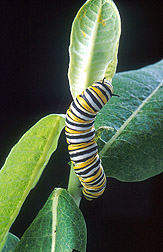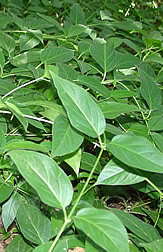This page has been archived and is being provided for reference purposes only. The page is no longer being updated, and therefore, links on the page may be invalid.
|
Study Targets Invasive "Dog-Strangling" Vines
By Luis PonsJune 27, 2006
Two invasive and destructive plants known as "dog-strangling" vines are spreading uncontrolled through large areas of New York, New England and Ontario, prompting Agricultural Research Service (ARS) and Cornell University scientists to launch a study to find biological ways to stop them.
The targets of the three-year study—which is being led by entomologist Lindsey Milbrath of the ARS Plant Protection Research Unit (PPRU) in Ithaca, N.Y.—are two members of the milkweed family known as pale swallow-wort and black swallow-wort.
Both plant species originated in Europe. Pale swallow-wort (Vincetoxicum rossicum) comes from the Ukraine, and black swallow-wort (V. nigrum) is from southwestern Europe. On their home grounds, both are kept in check by native natural enemies, particularly insects and diseases. But so far, nothing on these shores has halted their advance. According to Milbrath, the vines contain strong and unique poisons that probably limit natural enemies here and keep deer and cattle from feeding on them.
Cornell research has shown that the pink-flowered pale swallow-wort grows rapidly in forest understories and in open fields of undisturbed soil throughout central and upstate New York, around the Great Lakes and in Canada. The purple-flowered black swallow-wort prefers open areas. It’s found primarily in New York's Hudson Valley and Long Island, as well as throughout New England.
Although both swallow-worts share the ominous "dog-strangling" moniker, they’re actually a threat to Monarch butterflies. Pale swallow-wort may be replacing common milkweeds in open fields upon which monarch larvae feed. The butterflies' larvae are unable to survive on either plant species.
Also, the vines have pushed onto reduced-tillage corn and soybean fields and impacted forest regeneration.
Working with Milbrath on the study are Cornell weed ecologist Antonio DiTommaso; PPRU plant physiologist Donna Gibson; Dana Berner of the ARS Foreign Disease-Weed Science Research Unit in Ft. Detrick, Md.; and scientists at the ARS European Biological Control Laboratory in Montpellier, France.
ARS is the U.S. Department of Agriculture's chief scientific research agency.


